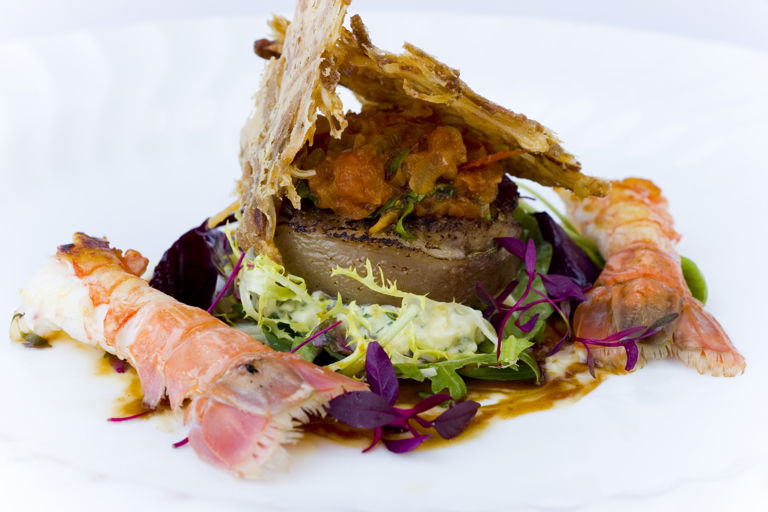Rolled pig's head with langoustine and a crispy ear salad
Item 1 of 1
- 4
- 5 hours
A signature dish of The Kitchin restaurant, this pork and langoustine recipe requires a fair amount of patience and finesse, as well as some butchery skills. Rest assured though, it is well worth the effort.
First published in 2015
discover more:
Ingredients
Metric
Imperial
Rolled pig's head
- 1 pig's head
- 2 carrots, roughly chopped
- 1 celery stick, roughly chopped
- 1 white onion, roughly chopped
- 2 bay leaves
- 1 sprig of fresh thyme
- 1 tsp herbes de Provence
- 1 tsp ground cumin
- 1 tsp fennel seeds
- salt
- pepper
- olive oil
Tomato concasse
- 5 plum tomatoes
- 1 garlic clove, peeled
- 1 sprig of fresh thyme
- salt
- pepper
Sauce Gribiche
- 6 free-range eggs
- 1 tsp Dijon mustard
- 25ml of white wine vinegar
- 250ml of vegetable oil
- 1 tbsp of capers, chopped
- 1 tbsp of gherkins, chopped
- 1 tbsp of parsley, chopped
- salt
To serve
- 12 langoustines
- 80g of mixed salad leaves
- olive oil
- salt
- pepper
SAVE RECIPE
Equipment
- Blow torch
- Muslin cloth
Method
1
To prepare the pig's head, remove all the excess hair with a blow torch. Using a very sharp knife, cut all the way down the middle of the head to the snout. Cut away the meat keeping it attached to the skin
2
Remove the ears and tie the head together with string, place into a large pan with the vegetables and cover with water, cook for one hour
- 2 carrots, roughly chopped
- 1 celery stick, roughly chopped
- 1 white onion, roughly chopped
- 2 bay leaves
- 1 sprig of fresh thyme
3
Wrap the ears in muslin and add to the pan with the head cook for another 4 hours
4
If necessary, top up with water during the cooking process to ensure the contents are completely covered. After the 5 hours cooking time, remove the ears from the pan and allow the head to cool in the cooking liquor
5
Trim the muscles from the ears and tightly wrap in clingfilm. Press under a weight in the fridge overnight.
6
While still slightly warm, remove the cheeks from the head and separate the fat and meat from the skin. Discard the fat. Roll a piece of clingfilm out onto a chopping board and lay the skin outer side down.
7
Shred the meat from the cheeks into a bowl and mix with the herbs, cumin, fennel and a pinch of salt and pepper
- 1 tsp herbes de Provence
- 1 tsp ground cumin
- 1 tsp fennel seeds
- salt
- pepper
8
Place an even line of shredded cheek mixture in the middle of the skin and roll into a tight sausage, approximately 6cm in diameter. Wrap tightly in the cling film and leave to set in the fridge for 12 hours or overnight
9
Preheat the oven to 170˚C/gas mark 3. Use a sharp knife to shred the ears into very fine strips. Place a frying pan over a medium-high-heat and add the olive oil
- olive oil
10
Spread the pig's ears evenly into the pan and fry for 2-3 minutes, then place in the oven for 15-20 minutes until they start to sizzle and crisp up
11
Remove from the oven, place on absorbent kitchen towel and store in a warm place until required
12
During the time that the ears are setting, prepare the tomato concasse. Blanch and peel the tomatoes. Cut into quarters and remove the seeds. Add to a heavy-based saucepan over a low heat with the garlic and thyme
- 20 plum tomatoes
- 5 garlic cloves, peeled
- 2 sprigs of fresh thyme
14
For the sauce gribiche, hard boil the eggs in boiling water for 8-10 minutes. Drain and place in cold water to cool. Peel and finely chop the eggs and set aside
15
In a large bowl, whisk together the mustard and vinegar. Add the vegetable oil in a steady, thin stream - whisking continuously until completely emulsified. Mix in the capers, gherkins, parsley and a pinch of salt. Store in the fridge until ready to use - the sauce will keep for 2-3 days
- 1 tsp Dijon mustard
- 25ml of white wine vinegar
- 250ml of vegetable oil
- 1 tbsp of capers, chopped
- 1 tbsp of gherkins, chopped
- 1 tbsp of parsley
- salt
16
Slice the pigs head into 3cm rounds and fry until crispy
17
To cook the langoustines, peel and remove all the shell apart from the tail. Use a knife to gently scrape away and remove the intestinal tract from the back of the langoustine
- 12 langoustines
19
To serve, place a few salad leave and a spoon of sauce Gribiche in the middle of the plate. Put a piece of pigs head on top and garnish with the tomato concasse. Scatter around the crisp pigs ears and serve with the langoustines.
- 80g of mixed salad leaves
Get in touch
Please sign in or register to send a comment to Great British Chefs.



